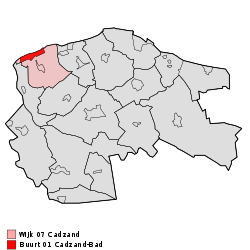Cadzand bath
| province |
|
| local community |
|
|
Area - land - water |
1.32 km 2 1.31 km 2 0.01 km 2 |
| Residents | 190 (Jan. 1, 2017) |
| Coordinates | 51 ° 22 ′ N , 3 ° 23 ′ E |
| prefix | 0117 |
| Postcodes | 4506, 4525 |
| Location of Cadzand-Bad in the municipality of Sluis | |
Cadzand-Bad is the southernmost coastal town in the Netherlands near the Belgian border.
location
Cadzand-Bad and Cadzand-Dorf inland belong to the large municipality of Sluis , which is located in the southwestern part of the province of Zeeland and forms the westernmost third of Zeeuws Vlaanderen . Zeeuws Vlaanderen is separated from the actual Dutch mainland by the broad Westerschelde . It lies like a peninsula in the north of Belgium and has a connection to the other peninsulas of Zeeland and thus to the rest of the Netherlands only through the Westerschelde tunnel near Terneuzen .
The village with 180 inhabitants stretches along the North Sea. The five kilometer long sandy beach runs from the Belgian border from the southwest from the nature reserve Het Zwin (a large bird sanctuary on the Belgian side) to the nature reserve De Zwarte Polder in the northeast. The central axis of the place is the Boulevard de Wielingen.
Infrastructure
tourism
The place lives mostly from tourism, eleven broker offices can be found in Cadzand-Bad. The main street of the village, the Boulevard de Wielingen, is home to a few restaurants and shops, alongside a few blocks of flats.
Marina
Since May 2017, Cadzand-Bad has had a marina with 125 berths, a restaurant and a café on the south-western outskirts of the town in front of the discharge canal.
Fossil site
The beaches at Cadzand-Bad are known as good sites for shark teeth from the Neogene and Paleogene . The tidal current and the current of the Westerschelde erode layers on the seabed off the coast that contain fossils (shark teeth, ray teeth, other fish teeth) as well as mussels, teeth and vertebrae of fish and whales, crab parts, bones of mammals and birds. These are then washed up on the beaches by the tides . In addition, the beaches, which are important for tourism, are occasionally washed up in the winter months in order to increase them. The material for this comes from the Westerschelde. Depending on which layers are sucked in, fossil material also gets onto the beaches with the sand.
Trivia
Cadzand-Bad is considered to be the place with the most hours of sunshine per year in the Netherlands .
Web links
- Info portal about Cadzand-Bad (German)
- Information on the website of the municipality of Sluis (Dutch)
Individual evidence
- ↑ Kerncijfers wijken en buurten 2017 Centraal Bureau voor de Statistiek , accessed on April 10, 2018 (Dutch)
- ↑ Broker in Cadzand ( Memento of the original from March 4, 2016 in the Internet Archive ) Info: The archive link was automatically inserted and not yet checked. Please check the original and archive link according to the instructions and then remove this notice. cadzand-online.de, accessed on February 8, 2015
- ↑ Cadzand-Bad - Tourismus lasaludfamiliar.com, accessed on February 8, 2015
- ↑ [1] pzc.nl, accessed on April 10, 2016
- ^ Hours of sunshine in Cadzand niederlande-wegweiser.de, accessed on February 9, 2015
- ↑ hours of sunshine in Cadzand lasaludfamiliar.com, accessed on February 9, 2015


